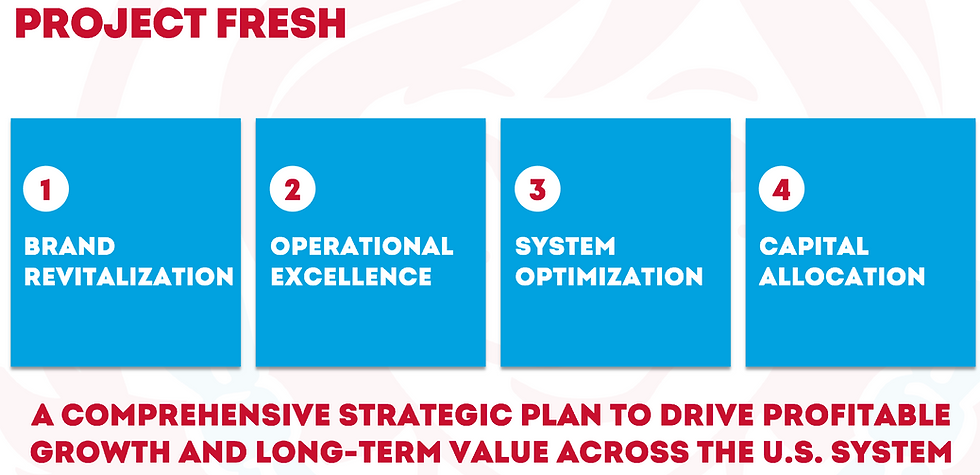Chipotle Earnings: Margins Narrow as Brand Bets on Value and Innovation
- Hardik Shah
- Oct 29
- 4 min read

TLDR
• Revenue Strength: Sales rose 7.5% to $3.0B, led by new openings and modest comp gains.
• Margin Trends: Restaurant-level margin fell 100 bps to 24.5% on inflation and tariffs.
• Forward Outlook: Management sees low-single-digit comp declines in 2025, but remains bullish on long-term growth through “Recipe for Growth.”
Business Overview
Chipotle Mexican Grill (NYSE: CMG) operates over 3,900 restaurants globally, all company-owned in North America and Europe. The fast-casual chain serves customizable Mexican-inspired meals emphasizing fresh, responsibly sourced ingredients—an offering it calls “Food with Integrity.” Chipotle continues to expand its Chipotlane drive-thru format, which now represents over 80% of new U.S. openings, while also entering international markets via partner-operated locations in the Middle East and Asia.
Chipotle Earnings
Top Line:Q3 2025 revenue grew 7.5% year-over-year to $3.0 billion, driven by new restaurant openings and a 0.3% comparable sales increase, supported by a 1.1% rise in average check but offset by lower traffic (-0.8%). Digital sales comprised 36.7% of revenue.
Margins & Profitability:
Restaurant-level operating margin: 24.5% (-100 bps YoY)
Operating margin: 15.9% (-100 bps YoY)
GAAP EPS: $0.29 (+3.6% YoY)
Adjusted EPS: $0.29 (+7.4% YoY)
Net income: $382 million
Food and packaging costs fell slightly to 30.0% of revenue, benefiting from 2024 price actions, partially offset by inflation in beef and chicken and new tariffs. Labor costs rose to 25.2%, reflecting wage inflation and lower throughput. Marketing spend increased to 3% of sales, as the company leaned into promotions and product launches.
Forward Guidance
Management Outlook:Chipotle projects low-single-digit declines in comparable restaurant sales for 2025 and plans 315–345 new openings, with more than 80% including Chipotlanes. The company expects 350–370 new openings in 2026, adding up to 15 international units. Its effective tax rate should land between 25–27%.
Risks & Opportunities:CFO Adam Rymer cited tariff-related inflation (~50 bps impact) and rising beef costs as key near-term pressures. He emphasized Chipotle will not fully offset inflation with pricing to protect guest value perception. CEO Scott Boatwright reaffirmed the long-term goal of 7,000 North American restaurants and mid-single-digit comp growth once the consumer backdrop improves.
Operational Performance
Chipotle opened 84 new company-owned restaurants in Q3 (64 with Chipotlanes), maintaining industry-leading new-unit productivity (~80%) and ~60% year-two cash returns. The company is also rolling out its High-Efficiency Equipment Package (HEAP)—including dual-sided planchas and high-capacity fryers—expected to enhance throughput and consistency. Pilot locations report improved culinary quality, faster prep times, and better labor efficiency, with full rollout planned over three years.
Market Insights
Management acknowledged persistent consumer headwinds, particularly among households earning under $100K—a group that represents about 40% of Chipotle’s sales. These guests have reduced dining frequency amid inflation, student loan repayments, and slower wage growth. Still, Chipotle has maintained share, with traffic declines attributed to “food-at-home” trade-down rather than competitive losses.
Consumer Behavior & Sentiment
CEO Scott Boatwright emphasized that Chipotle’s value proposition remains structurally strong, offering generous portions, fresh ingredients, and price points 20–30% below fast-casual peers. The company is revamping marketing to better communicate value without relying on discounts, supported by loyalty-driven promotions such as “Summer of Extras,” “Chipotle IQ,” and “Freepotle”, which lifted engagement across cohorts.
“Our value proposition has never been stronger. Now it’s about delivering that experience consistently across 4,000 restaurants every day,” said CEO Scott Boatwright.
Strategic Initiatives
Chipotle is accelerating menu innovation, introducing Red Chimichurri and Adobo Ranch, both of which drove incremental traffic. Plans for 2026 include three to four limited-time protein launches and an expanded sides and dips platform. The company also launched a catering pilot in Chicago, supported by upgraded kitchen equipment and a new tech stack. Catering currently represents only 1–2% of sales, leaving room for significant growth versus peers at 5–10%.
“We’re using this challenging period to strengthen our consumer flywheel—improving execution, enhancing communication of value, and accelerating innovation,” Boatwright noted.
On digital, Chipotle is expanding its Rewards ecosystem, adding gamified experiences and university-specific initiatives (Chipotle U) to boost frequency and loyalty. The company also hinted at a forthcoming “Recipe for Growth” roadmap—a three-pronged plan centered on operations, digital engagement, and marketing clarity.
Capital Allocation
Chipotle repurchased $686 million of stock in Q3 at an average of $42.39 per share and ended the quarter with $652 million remaining under authorization.
The balance sheet remains debt-free with $1.8 billion in cash and investments.
The company continues to prioritize share repurchases over dividends, citing flexibility amid expansion plans.
The Bottom Line
Chipotle’s Q3 results show solid top-line growth but ongoing traffic softness amid a strained consumer backdrop. Management’s decision to protect value over margin reinforces long-term brand equity, even as inflation and tariffs pressure near-term profitability.
For investors, key watchpoints include:
Traffic stabilization among sub-$100K income cohorts.
HEAP rollout impact on throughput and labor efficiency.
International expansion via partner-operated restaurants.
With strong brand equity and a debt-free balance sheet, Chipotle remains well-positioned for a rebound once consumer sentiment turns.
--



Comments